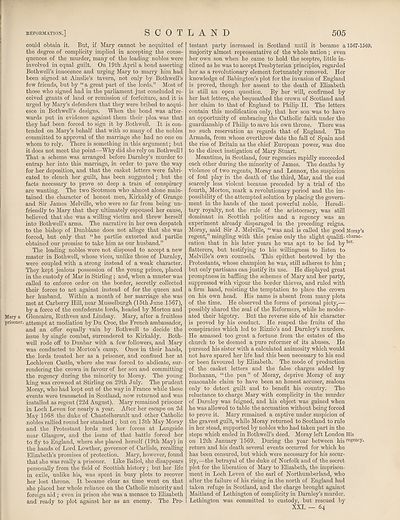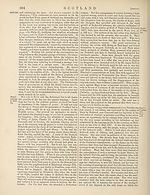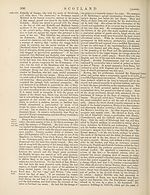Encyclopaedia Britannica > Volume 21, ROT-Siam
(515) Page 505
Download files
Complete book:
Individual page:
Thumbnail gallery: Grid view | List view

505
REFORMATION.] SCOT
could obtain it. But, if Mary cannot be acquitted of
the degree of complicity implied in accepting the conse¬
quences of the murder, many of the leading nobles were
involved in equal guilt. On 19th April a bond asserting
Bothwell’s innocence and urging Mary to marry him had
been signed at Ainslie’s tavern, not only by BothwelPs
few friends, but by “ a great part of the lords.” Most of
those who signed had in the parliament just concluded re¬
ceived grants of land or remission of forfeiture, and it is
urged by Mary’s defenders that they were bribed to acqui¬
esce in Bothwell’s designs. When the bond was after¬
wards put in evidence against them their plea was that
they had been forced to sign it by Bothwell. It is con¬
tended on Mary’s behalf that with so many of the nobles
committed to approval of the marriage she had no one on
whom to rely. There is something in this argument; but
it does not meet the point—Why did she rely on Bothwell 1
That a scheme was arranged before Darnley’s murder to
entrap her into this marriage, in order to pave the way
for her deposition, and that the casket letters were fabri¬
cated to clench her guilt, has been suggested; but the
facts necessary to prove so deep a train of conspiracy
are wanting. The two Scotsmen who almost alone main¬
tained the character of honest men, Kirkaldy of Grange
and Sir James Melville, who were so far from being un¬
friendly to Mary that they ultimately espoused her cause,
believed that she was a willing victim and threw herself
into Bothwell’s arms. The narrative in her own despatch
to the bishop of Dunblane does not allege that she was
forced, but only that “he partlie extorted and partlie
obtained our promise to take him as our husband.”
The leading nobles were not disposed to accept a new
master in Bothwell, whose vices, unlike those of Darnley,
were coupled with a strong instead of a weak character.
They kept jealous possession of the young prince, placed
in the custody of Mar in Stirling ; and, when a muster was
called to enforce order on the border, secretly collected
their forces to act against instead of for the queen and
her husband. Within a month of her marriage she was
met at Carberry Hill, near Musselburgh (15th June 1567),
by a force of the confederate lords, headed by Morton and
Mary a Glencairn, Ruthven and Lindsay. Mary, after a fruitless
prisoner, attempt at mediation by Du Croc, the French ambassador,
and an offer equally vain by Bothwell to decide the
issue by single combat, surrendered to Kirkaldy. Both¬
well rode off to Dunbar with a few followers, and Mary
was conducted to Morton’s camp. Once in their hands,
the lords treated her as a prisoner, and confined her at
Lochleven Castle, where she was forced to abdicate, sur¬
rendering the crown in favour of her son and committing
the regency during the minority to Moray. The young
king was crowned at Stirling on 29th July. The prudent
Moray, who had kept out of the way in France while these
events were transacted in Scotland, now returned and was
installed as regent (22d August). Mary remained prisoner
in Loch Leven for nearly a year. After her escape on 2d
May 1568 the duke of Chastelherault and other Catholic
nobles rallied round her standard ; but on 13th May Moray
and the Protestant lords met her forces at Langside
near Glasgow, and the issue of that battle forced her
to fly to England, where she placed herself (19th May) in
the hands of Lord Lowther, governor of Carlisle, recalling
Elizabeth’s promises of protection. Mary, however, found
that she was really a prisoner. Like Baliol, she disappears
personally from the field of Scottish history; but her life
in exile, unlike his, was spent in busy plots to recover
her lost throne. It became clear as time went on that
she placed her whole reliance on the Catholic minority and
foreign aid; even in prison she was a menace to Elizabeth
and ready to plot against her as an enemy. The Pro-
L A N D
testant party increased in Scotland until it became a 1567-1569.
majority almost representative of the whole nation ; even
her own son when he came to hold the sceptre, little in¬
clined as he was to accept Presbyterian principles, regarded
her as a revolutionary element fortunately removed. Her
knowledge of Babington’s plot for the invasion of England
is proved, though her assent to the death of Elizabeth
is still an open question. By her will, confirmed by
her last letters, she bequeathed the crown of Scotland and
her claim to that of England to Philip II. The letters
contain this modification only, that her son was to have
an opportunity of embracing the Catholic faith under the
guardianship of Philip to save his own throne. There was
no such reservation as regards that of England. The
Armada, from whose overthrow date the fall of Spain and
the rise of Britain as the chief European power, was due
to the direct instigation of Mary Stuart.
Meantime, in Scotland, four regencies rapidly succeeded
each other during the minority of James. The deaths by
violence of two regents, Moray and Lennox, the suspicion
of foul play in the death of the third, Mar, and the end
scarcely less violent because preceded by a trial of the
fourth, Morton, mark a revolutionary period and the im¬
possibility of the attempted solution by placing the govern¬
ment in the hands of the most powerful noble. Heredi¬
tary royalty, not the rule of the aristocracy, was still
dominant in Scottish politics and a regency was an
experiment already disparaged in the preceding reigns.
Moray, said Sir J. Melville, “ was and is called the good Moray’s
regent,” mingling with this praise only the slight qualifi- charac-
cation that in his later years he was apt to be led byter'
flatterers, but testifying to his willingness to listen to
Melville’s own counsels. This epithet bestowed by the
Protestants, whose champion he was, still adheres to him ;
but only partisans can justify its use. He displayed great
promptness in baffling the schemes of Mary and her party,
suppressed with vigour the border thieves, and ruled with
a firm hand, resisting the temptation to place the crown
on his own head. His name is absent from many plots
of the time. He observed the forms of personal piety,—
possibly shared the zeal of the Reformers, while he moder¬
ated their bigotry. But the reverse side of his character
is proved by his conduct. He reaped the fruits of the
conspiracies which led to Rizzio’s and Darnley’s murders.
He amassed too great a fortune from the estates of the
church to be deemed a pure reformer of its abuses. He
pursued his sister with a calculated animosity which would
not have spared her life had this been necessary to his end
or been favoured by Elizabeth. The mode of production
of the casket letters and the false charges added by
Buchanan, “the pen” of Moray, deprive Moray of any
reasonable claim to have been an honest accuser, zealous
only to detect guilt and to benefit his country. The
reluctance to charge Mary with complicity in the murder
of Darnley was feigned, and his object was gained when
he was allowed to table the accusation without being forced
to prove it. Mary remained a captive under suspicion of
the gravest guilt, while Moray returned to Scotland to rule
in her stead, supported by nobles who had taken part in the
steps which ended in Bothwell’s deed. Moray left London His
on 12th January 1569. During the year between his ’vg^iey.
return and his death several events occurred for which he
has been censured, but which were necessary for his secur¬
ity,—the betrayal of the duke of Norfolk and of the secret
plot for the liberation of Mary to Elizabeth, the imprison¬
ment in Loch Leven of the earl of Northumberland, who
after the failure of his rising in the north of England had
taken refuge in Scotland, and the charge brought against
Maitland of Lethington of complicity in Darnley’s murder.
Lethington was committed to custody, but rescued by
XXL — 64
REFORMATION.] SCOT
could obtain it. But, if Mary cannot be acquitted of
the degree of complicity implied in accepting the conse¬
quences of the murder, many of the leading nobles were
involved in equal guilt. On 19th April a bond asserting
Bothwell’s innocence and urging Mary to marry him had
been signed at Ainslie’s tavern, not only by BothwelPs
few friends, but by “ a great part of the lords.” Most of
those who signed had in the parliament just concluded re¬
ceived grants of land or remission of forfeiture, and it is
urged by Mary’s defenders that they were bribed to acqui¬
esce in Bothwell’s designs. When the bond was after¬
wards put in evidence against them their plea was that
they had been forced to sign it by Bothwell. It is con¬
tended on Mary’s behalf that with so many of the nobles
committed to approval of the marriage she had no one on
whom to rely. There is something in this argument; but
it does not meet the point—Why did she rely on Bothwell 1
That a scheme was arranged before Darnley’s murder to
entrap her into this marriage, in order to pave the way
for her deposition, and that the casket letters were fabri¬
cated to clench her guilt, has been suggested; but the
facts necessary to prove so deep a train of conspiracy
are wanting. The two Scotsmen who almost alone main¬
tained the character of honest men, Kirkaldy of Grange
and Sir James Melville, who were so far from being un¬
friendly to Mary that they ultimately espoused her cause,
believed that she was a willing victim and threw herself
into Bothwell’s arms. The narrative in her own despatch
to the bishop of Dunblane does not allege that she was
forced, but only that “he partlie extorted and partlie
obtained our promise to take him as our husband.”
The leading nobles were not disposed to accept a new
master in Bothwell, whose vices, unlike those of Darnley,
were coupled with a strong instead of a weak character.
They kept jealous possession of the young prince, placed
in the custody of Mar in Stirling ; and, when a muster was
called to enforce order on the border, secretly collected
their forces to act against instead of for the queen and
her husband. Within a month of her marriage she was
met at Carberry Hill, near Musselburgh (15th June 1567),
by a force of the confederate lords, headed by Morton and
Mary a Glencairn, Ruthven and Lindsay. Mary, after a fruitless
prisoner, attempt at mediation by Du Croc, the French ambassador,
and an offer equally vain by Bothwell to decide the
issue by single combat, surrendered to Kirkaldy. Both¬
well rode off to Dunbar with a few followers, and Mary
was conducted to Morton’s camp. Once in their hands,
the lords treated her as a prisoner, and confined her at
Lochleven Castle, where she was forced to abdicate, sur¬
rendering the crown in favour of her son and committing
the regency during the minority to Moray. The young
king was crowned at Stirling on 29th July. The prudent
Moray, who had kept out of the way in France while these
events were transacted in Scotland, now returned and was
installed as regent (22d August). Mary remained prisoner
in Loch Leven for nearly a year. After her escape on 2d
May 1568 the duke of Chastelherault and other Catholic
nobles rallied round her standard ; but on 13th May Moray
and the Protestant lords met her forces at Langside
near Glasgow, and the issue of that battle forced her
to fly to England, where she placed herself (19th May) in
the hands of Lord Lowther, governor of Carlisle, recalling
Elizabeth’s promises of protection. Mary, however, found
that she was really a prisoner. Like Baliol, she disappears
personally from the field of Scottish history; but her life
in exile, unlike his, was spent in busy plots to recover
her lost throne. It became clear as time went on that
she placed her whole reliance on the Catholic minority and
foreign aid; even in prison she was a menace to Elizabeth
and ready to plot against her as an enemy. The Pro-
L A N D
testant party increased in Scotland until it became a 1567-1569.
majority almost representative of the whole nation ; even
her own son when he came to hold the sceptre, little in¬
clined as he was to accept Presbyterian principles, regarded
her as a revolutionary element fortunately removed. Her
knowledge of Babington’s plot for the invasion of England
is proved, though her assent to the death of Elizabeth
is still an open question. By her will, confirmed by
her last letters, she bequeathed the crown of Scotland and
her claim to that of England to Philip II. The letters
contain this modification only, that her son was to have
an opportunity of embracing the Catholic faith under the
guardianship of Philip to save his own throne. There was
no such reservation as regards that of England. The
Armada, from whose overthrow date the fall of Spain and
the rise of Britain as the chief European power, was due
to the direct instigation of Mary Stuart.
Meantime, in Scotland, four regencies rapidly succeeded
each other during the minority of James. The deaths by
violence of two regents, Moray and Lennox, the suspicion
of foul play in the death of the third, Mar, and the end
scarcely less violent because preceded by a trial of the
fourth, Morton, mark a revolutionary period and the im¬
possibility of the attempted solution by placing the govern¬
ment in the hands of the most powerful noble. Heredi¬
tary royalty, not the rule of the aristocracy, was still
dominant in Scottish politics and a regency was an
experiment already disparaged in the preceding reigns.
Moray, said Sir J. Melville, “ was and is called the good Moray’s
regent,” mingling with this praise only the slight qualifi- charac-
cation that in his later years he was apt to be led byter'
flatterers, but testifying to his willingness to listen to
Melville’s own counsels. This epithet bestowed by the
Protestants, whose champion he was, still adheres to him ;
but only partisans can justify its use. He displayed great
promptness in baffling the schemes of Mary and her party,
suppressed with vigour the border thieves, and ruled with
a firm hand, resisting the temptation to place the crown
on his own head. His name is absent from many plots
of the time. He observed the forms of personal piety,—
possibly shared the zeal of the Reformers, while he moder¬
ated their bigotry. But the reverse side of his character
is proved by his conduct. He reaped the fruits of the
conspiracies which led to Rizzio’s and Darnley’s murders.
He amassed too great a fortune from the estates of the
church to be deemed a pure reformer of its abuses. He
pursued his sister with a calculated animosity which would
not have spared her life had this been necessary to his end
or been favoured by Elizabeth. The mode of production
of the casket letters and the false charges added by
Buchanan, “the pen” of Moray, deprive Moray of any
reasonable claim to have been an honest accuser, zealous
only to detect guilt and to benefit his country. The
reluctance to charge Mary with complicity in the murder
of Darnley was feigned, and his object was gained when
he was allowed to table the accusation without being forced
to prove it. Mary remained a captive under suspicion of
the gravest guilt, while Moray returned to Scotland to rule
in her stead, supported by nobles who had taken part in the
steps which ended in Bothwell’s deed. Moray left London His
on 12th January 1569. During the year between his ’vg^iey.
return and his death several events occurred for which he
has been censured, but which were necessary for his secur¬
ity,—the betrayal of the duke of Norfolk and of the secret
plot for the liberation of Mary to Elizabeth, the imprison¬
ment in Loch Leven of the earl of Northumberland, who
after the failure of his rising in the north of England had
taken refuge in Scotland, and the charge brought against
Maitland of Lethington of complicity in Darnley’s murder.
Lethington was committed to custody, but rescued by
XXL — 64
Set display mode to:
![]() Universal Viewer |
Universal Viewer | ![]() Mirador |
Large image | Transcription
Mirador |
Large image | Transcription
Images and transcriptions on this page, including medium image downloads, may be used under the Creative Commons Attribution 4.0 International Licence unless otherwise stated. ![]()
| Encyclopaedia Britannica > Encyclopaedia Britannica > Volume 21, ROT-Siam > (515) Page 505 |
|---|
| Permanent URL | https://digital.nls.uk/193633974 |
|---|
| Attribution and copyright: |
|
|---|---|
| Shelfmark | EB.17 |
|---|---|
| Description | Ten editions of 'Encyclopaedia Britannica', issued from 1768-1903, in 231 volumes. Originally issued in 100 weekly parts (3 volumes) between 1768 and 1771 by publishers: Colin Macfarquhar and Andrew Bell (Edinburgh); editor: William Smellie: engraver: Andrew Bell. Expanded editions in the 19th century featured more volumes and contributions from leading experts in their fields. Managed and published in Edinburgh up to the 9th edition (25 volumes, from 1875-1889); the 10th edition (1902-1903) re-issued the 9th edition, with 11 supplementary volumes. |
|---|---|
| Additional NLS resources: |
|

